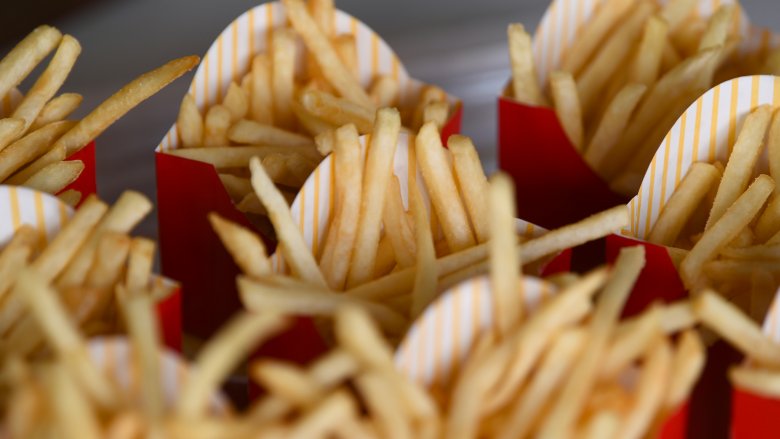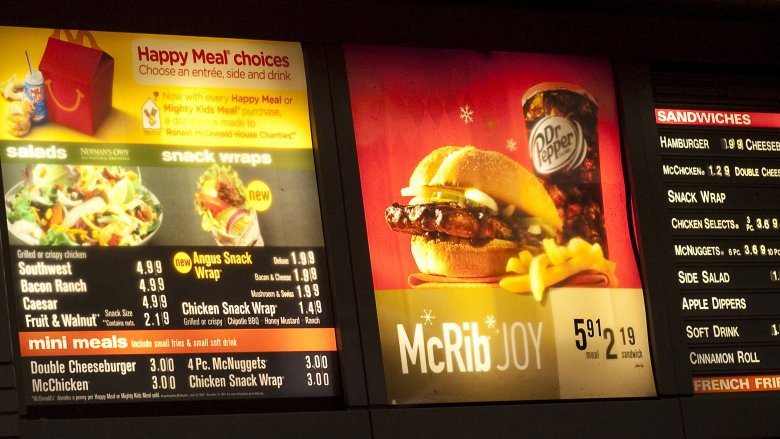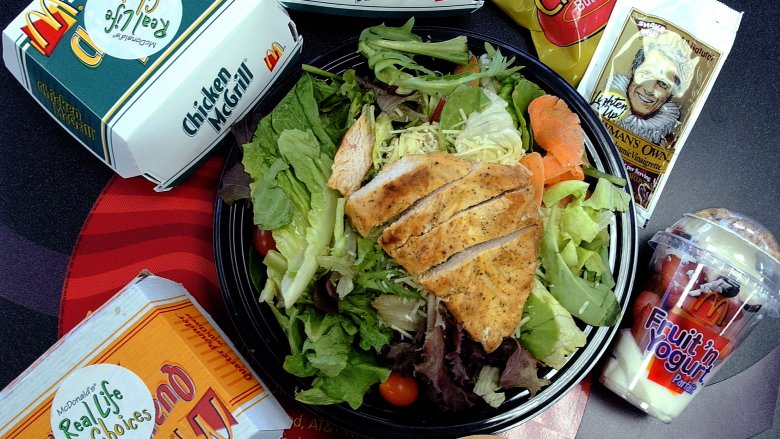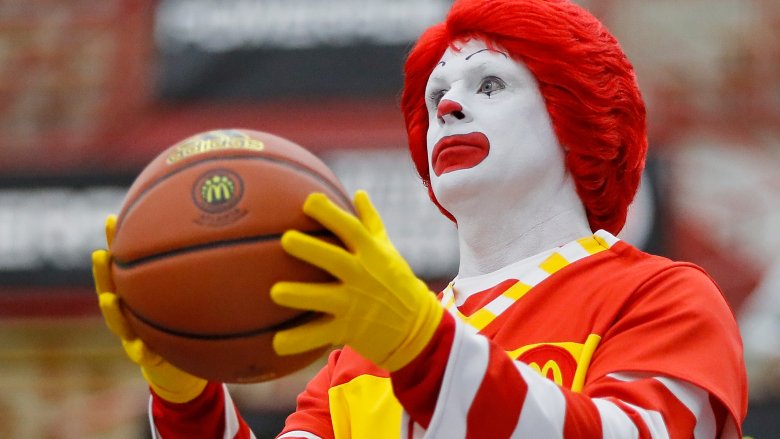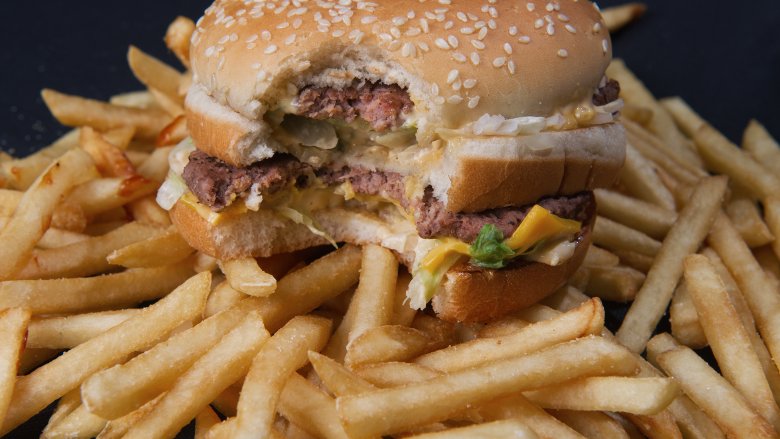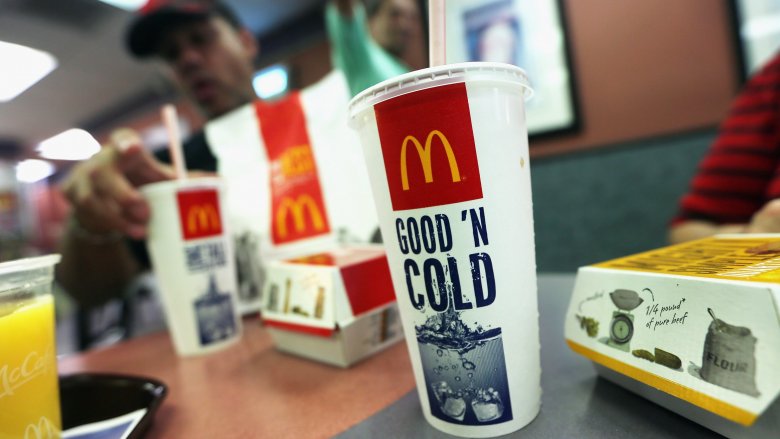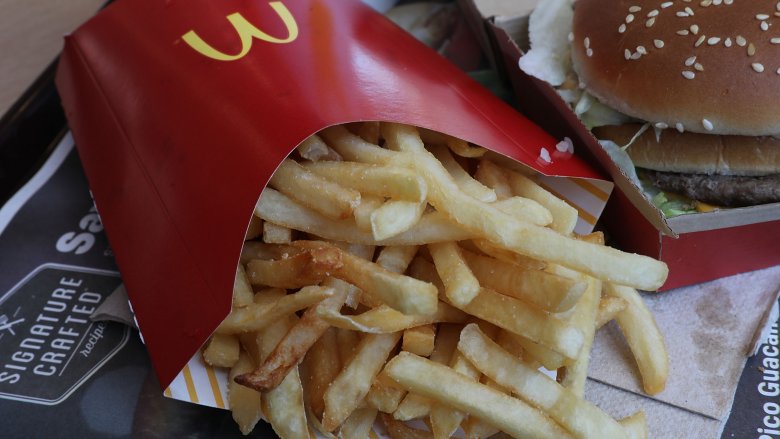The Real Reason Why McDonald's Supersized Menu Disappeared
McDonald's announced they were phasing out their signature Supersize fry and drink options in 2004, but years later, we're still using the term to refer to something extra-large, especially when the Golden Arches are involved. Supersizing was brilliant — who doesn't want more fries, after all — but wants and needs are two different things entirely.
The demise of the Supersize was a slow thing. According to CBS News, the plan to get rid of it was announced in March 2004, with a promise that by the end of the year, no location would be handing out those giant cups that absolutely wouldn't fit in your car's cup holder. They did say that it was possible they were going to return for the occasional promotion, giving fans of the Supersize fries and drinks a little bit of hope.
But, what gives? Really? Supersizing was so firmly associated with McDonald's and the cultural landscape of American fast food that we're still talking about it years later, so why did it disappear, anyway?
McDonald's gave one reason
The reason McDonald's officially gave for making the decision to get rid of Supersizing isn't the one you might expect.
Walt Riker, a spokesman for McDonald's, gave only one reason during a brief statement (via CBS News). According to him, "The driving force here was menu simplification."
Surprising, right? Especially considering that McDonald's has always had an issue with having a menu that some analysts suggest is just too big to keep costs down and speed of service up. According to Bloomberg (via Marketplace), McDonald's had 145 menu items in 2013, and that's 85 more than they had in 2007 — not too many years after Supersizing disappeared. The story came around the time McDonald's was saying goodbye to the Angus burger, the chicken selects, and some salads, and spokesperson Danya Proud said it was nothing out of the ordinary. "We add and remove menu items all the time," she wrote them in an email. "It's part of doing business for us and isn't new."
So taking menu items away isn't anything new for McDonald's, but having a simplified menu definitely is. That might be why not too many completely agreed with their public reasoning.
They were going healthier
The BBC linked the decision ditch Supersized items to something else — McDonald's awareness of the obesity epidemic gripping the first world. McDonald's, though, has said that the option to Supersize fries and drinks had nothing to do with causing obesity, so obesity had nothing to do with getting rid of the option.
But the BBC also noted that the announcement in the UK happened at the same time the British government was calling for people to take a good, long look at how they can overhaul their lifestyles to improve health on a national level.
CBS News, too, noted that the decision to get rid of Supersizing went hand-in-hand with increasing pressure being put on fast food restaurants to at least offer healthier alternatives to customers. They had already begun adding some of the healthier options that everyone is familiar with today, like fruit and yogurt, but at the time, they were still being heavily criticized for just how bad their food was. A little bit of public knowledge and awareness turned out to be not so great for the Golden Arches.
It didn't match their new initiative
Getting rid of Supersizing was, Entrepreneur says, actually done under the umbrella of McDonald's "Eat Smart, Be Active" initiative, which was launched in 2003. The campaign was geared toward not just making McDonald's healthier, but giving stagnant sales a much-needed boost. The brainchild of US operations chief Mike Roberts and first-year CEO Jim Cantalupo, it came with a ton of other little changes. At the same time Supersizing disappeared, they were also trading 2 percent milk for 1 percent, adding entree salads, and tweaking the sizes of other products, too.
This was all in 2003 and 2004, but strangely, McDonald's had originally experimented with adding salads long before — longer than you think. The Washington Post reported way back in 1986 that they were test marketing packaged salads at 1,000 locations across six different markets. At the time, they were one of the last holdouts when it came to offering a leafy green lunch.
Its popularity was fading
If you always said yes to Supersizing, you were actually in the minority. According to spokesperson Walt Riker (via CBS News), "The fact of the matter is not very many Supersize fries are sold."
That may come as a surprise to those of us who remember the Supersized menu with fondness, but it's true. The actual numbers are even more shocking — according to the BBC, Supersize options only accounted for .1 percent of McDonald's total sales at the time it was phased out.
Just what accounted for the fading popularity of Supersizing is likely a combination of factors, including customers that were becoming more and more health-conscious and saw declining the Supersize option as one of those ways to start making small changes in their everyday lives. Reactions to the announcement were mixed, but even some of those people who regularly opted for Supersizing found themselves throwing away a good amount of the fries and only actually finishing the drink. Cold fries are gross fries, after all, and with those numbers, it's really no wonder they decided not to keep all those giant containers around anymore.
Those obesity lawsuits didn't help
Supersizing was pretty much the perfect illustration of just why America's waistlines were continuing to expand, and by the early 2000s, Supersizing wasn't just becoming a joke, it was becoming the subject of lawsuits.
The New York Times reported on two teenagers taking McDonald's to court and suing them for essentially making them overweight. They argued that McDonald's hadn't provided the nutritional information on the meals they liked — Supersized portions and Happy Meals were specifically named — and if they had, they wouldn't have eaten it daily. Also in 2002, a man from the Bronx sued not just McDonald's but KFC, Wendy's, and Burger King as well, saying (via ABC News) that they had never disclosed just how bad their food was, and it led to his weight issues and ultimately his heart attack.
Those are just two of the lawsuits — The Washington Post says they were eventually tossed out of court, but they became such a big deal that 26 states actually went as far as banning obesity lawsuits. The laws banning these cases are called "commonsense consumption," and the fact that the suits (and resulting publicity) happened right before Supersizing disappeared can't be coincidence.
Super Size Me left a scar
When Morgan Spurlock named his expose film on the physical consequences of the fast food industry Super Size Me, it forever linked McDonald's trademark option with weight gain and a whole slew of health issues.
But spokesperson Walt Riker said (via CBS News) that the film had nothing to do with the disappearance of Supersizing. McDonald's official line on the film was that it wasn't actually a film about their food, it was about Spurlock making the incredibly bad choice to eat 5,000 calories a day (though those calories were all from McDonald's). Whether or not that's a legit interpretation, Refinery29 took a look at just how the film impacted consumers' perception of fast food and how they eat, and say that there was definitely a major impact.
It made countless people more aware of exactly what they're putting in the bodies, especially when it comes to fast food of all kinds. Even if McDonald's decision wasn't directly influenced by the film, it's easy to see how increasing awareness led to a shift in what customers wanted, and that, in turn, led to the fading popularity of supersizing — and ultimately the discontinuing of the line.
It's still around in spirit
Here's the super weird thing: Supersizing is no more, but when you actually compare current sizes to what you got when you Supersized something, there's not too much difference.
The BBC gave us the numbers: the difference between a large and a Supersized Coke was only a relatively small 97 calories in 2004. Not what you expected, is it? When it comes to the fries, a large had 412 calories and 18 grams of fat, and you were only getting 74 more calories and about 3 more grams of fat in the Supersized version. CBS News adds that a Supersized carton of fries held 7 ounces, and the large that stayed on the menu was a 6-ounce container.
That's... not that big of a deal, is it?
It's also worth this footnote: there might not be much difference in what you're getting, but McDonald's is the only chain of the big three to actually make their sizes smaller when they ditched their Supersizing. Wendy's "Biggie Size" left in 2006, and Refinery29 says today, we just call it a "medium." Similarly, Burger King's "King Size" option is now their large, and that sort of puts things in perspective, doesn't it?
